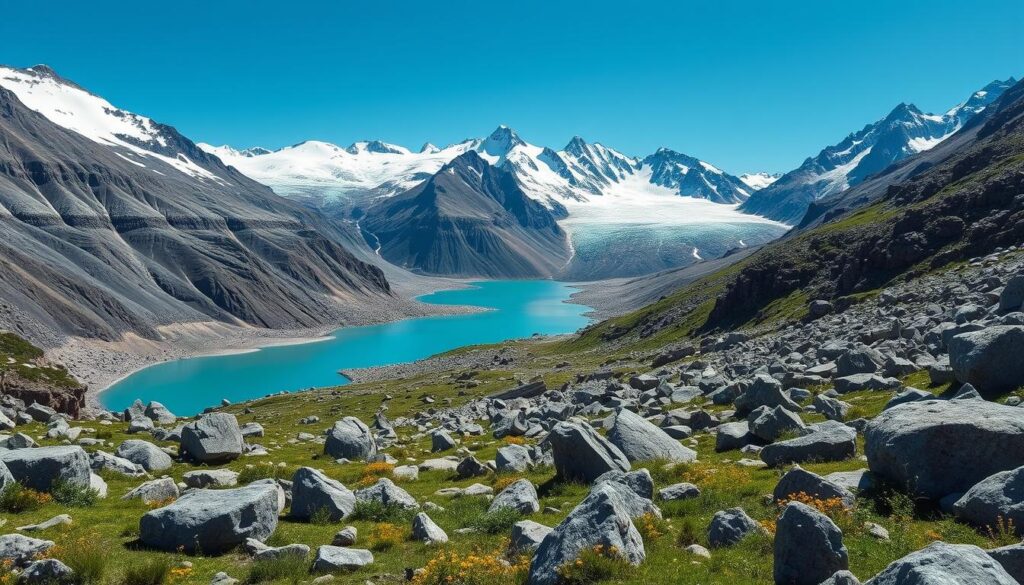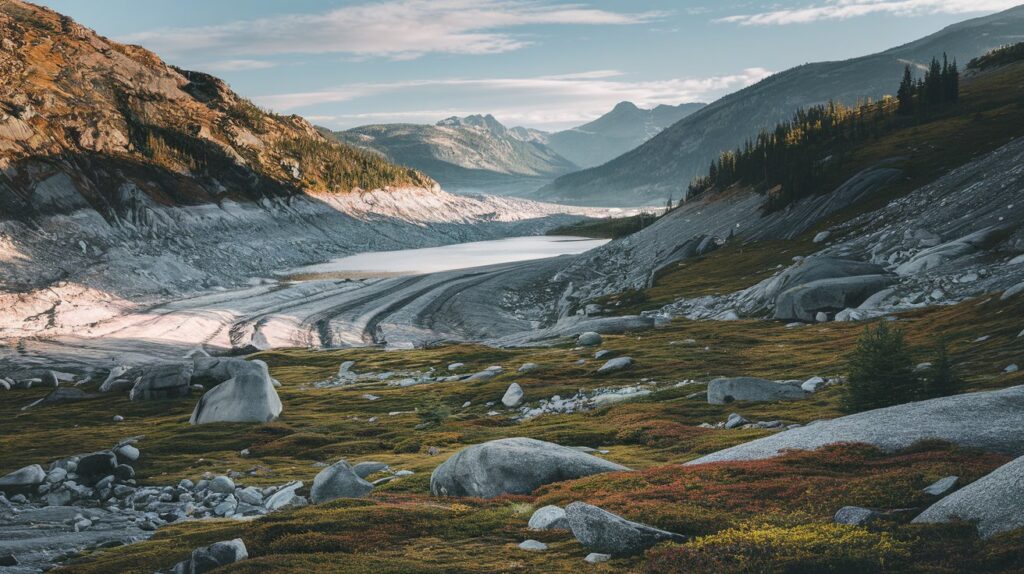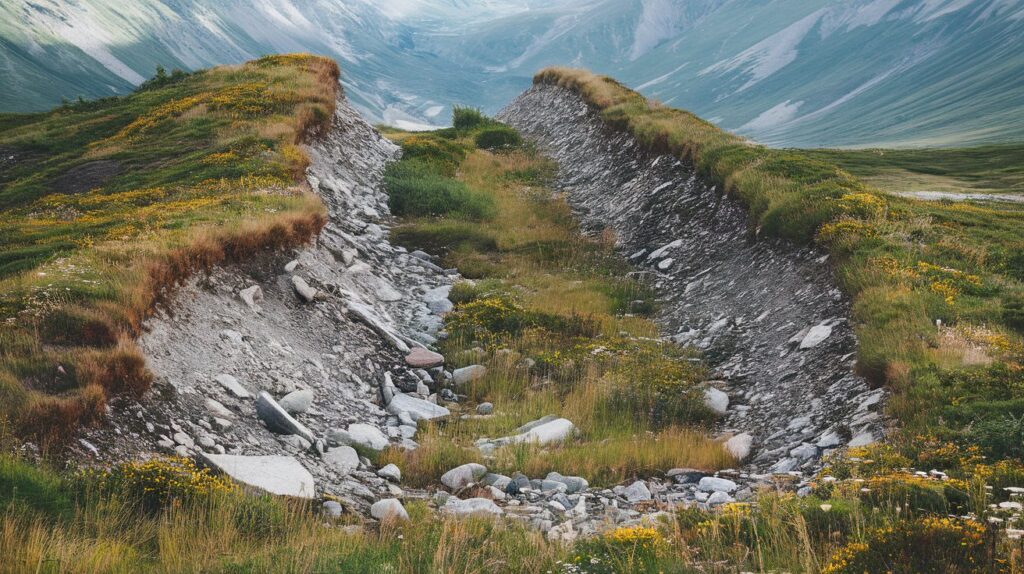
A vast glacial landscape featuring prominent end moraines, with jagged ridges of rocky debris, mingled with smooth, polished boulders. The scene showcases a serene icy blue lake reflecting the sky, surrounded by lush green vegetation and scattered wildflowers, under a dramatic backdrop of towering snow-capped mountains. Sunlight casts intricate shadows across the moraines, highlighting the textures and layers of glacial deposits.
End moraine is a ridge or series of ridges formed by drift. It’s built along the outer margin of an actively flowing glacier. This article explores end moraines, the distinctive glacial deposits that have shaped our landscapes. We’ll look at how these ridges form, their unique features, and their geological significance.
By the end, you’ll have a deeper appreciation for these important landforms. You’ll see their role in shaping the world around us.

Key Takeaways
- Ind moraine is a ridge or series of ridges formed by accumulations of drift built along the outer margin of an actively flowing glacier.
- End moraines are distinctive glacial deposits that have shaped the landscapes we see today.
- Understanding the formation and features of end moraines provides insights into past glacial processes.
- End moraines play a significant role in shaping glacial landscapes and understanding Earth’s geological history.
- Exploring end moraines can deepen our appreciation for the dynamic forces that have sculpted the world around us.
Understanding the Formation of End Moraines
End moraines are ridges at a glacier’s edge or end. They form through glacial movements and debris buildup. As a glacier moves, it picks up rocks, sediment, and more, known as glacial debris.
Glacial Movements and Debris Accumulation
The debris is carried and deposited at the glacier’s front. Over time, this creates a ridge or series of ridges called an end moraine. The size and shape of the moraine tell us about the glacier’s history and movement.
Types of End Moraines
There are several types of end moraines, each with its own features:
- Terminal Moraines – Formed at the furthest extent of a glacier’s advance, marking the maximum limit of its movement.
- Recessional Moraines – Created during temporary pauses or minor readvances in a glacier’s general retreat.
- Push Moraines – Formed when the glacier’s leading edge pushes and plows through pre-existing sediments, creating a ridge.
- Dump Moraines – Deposited when a glacier releases its load of glacial debris, often in a more irregular or chaotic pattern.
Knowing about these end moraine types helps us understand glacial landscapes better.
| Moraine Type | Description |
|---|---|
| Terminal Moraine | Formed at the furthest extent of a glacier’s advance, marking the maximum limit of its movement. |
| Recessional Moraine | Created during temporary pauses or minor readvances in a glacier’s general retreat. |
| Push Moraine | Formed when the glacier’s leading edge pushes and plows through pre-existing sediments, creating a ridge. |
| Dump Moraine | Deposited when a glacier releases its load of glacial debris, often in a more irregular or chaotic pattern. |

Distinctive Features of End Moraines
End moraines are unique glacial landforms with fascinating features. They have a ridge-like structure, often with parallel ridges marking a glacier’s former end. These ridges are made of glacial debris like rock fragments, boulders, and sediments.
End moraines also have varied topography, from gentle to irregular. This shows the complex glacial processes that shaped them. Kettle holes, small depressions from melted ice, are another feature, adding to their beauty and importance.
The size of end moraines varies, showing the glacier’s size and movement. They range from tall, steep ridges to low-lying features. These glacial deposits are key to understanding glacial landscapes in the United States and worldwide.
Important Point
| NO. | Important Points |
| 1. | About Us |
| 2. | Contact Us |
| 3. | Disclaimer |
| 4. | Privacy Policy |
FAQs of End Moraines
What are end moraines?
End moraines are special glacial deposits found at a glacier’s front. They are made of rock, sediment, and other materials picked up by the glacier.
How do end moraines form?
They form as a glacier moves and collects debris. This debris is then dropped at the glacier’s front, creating a ridge or mound.
What are the different types of end moraines?
There are several types, like terminal, recessional, and lateral moraines. Each type is named based on its location and how debris is deposited.
What are the distinctive features of end moraines?
They have a unique look, with ridges or hummocks. They also have big boulders and affect local water flow and lake formation.
What is the significance of end moraines in glacial landscapes?
They are key to understanding glacial history. They show how glaciers moved and retreated, helping scientists study glacial landscapes.
How can end moraines be used to study past climate conditions?
By analyzing the materials in end moraines, scientists can learn about past climates. This includes temperature, precipitation, and glacial activity.
